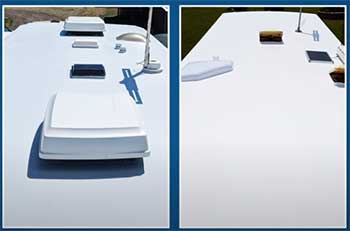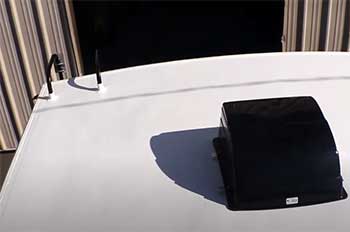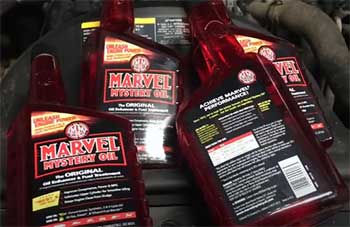So, why do you own an RV in the first place?
To have a lifetime of fun as you travel, of course! But a leaking roof can instantly hush your buzz and make it a hassle of extra work and expense.
So, why don’t we save you from that misery by checking out how some of the best RV roof treatments work? RV Armor is made using a layer of TPO membrane, while FlexArmor is made of polyurea. FlexArmor is significantly thicker than RV Armor.
And you know what, guys? It’s about to get even more interesting, so stick with me!
A Brief Comparison Table
| Product Specification | RV Armor | FlexArmor |
| Material Used | TPO membrane | Polyurea |
| Thickness | 30-60 mils | 187 mils |
| Curing Period | Four days | Seconds |
| Application Process | Simple and takes less time | Complex and time-consuming |
| Maintenance | Higher | Lower |
| Technique Used | Mopping | Spraying |
| Cost | $140 per linear foot | $170 per linear foot |
Core Differences Between RV Armor And FlexArmor
- Material Used
Ah, dearest RV roof!

Let’s get you away from your greatest enemy; leaks!
Once you’re committed to the vital task of sealing your roof, you must ensure you have the proper coatings on hand for the job.
And the material used plays a huge part in how effective the sealant will be.
RV Armor is made using a layer of TPO or, if you like, EPDM.
This coating perfectly flexes, making it an excellent choice for roofs. On top of that, it offers a high-quality protective barrier against UV rays and weather components.
In contrast, FlexArmor is made of polyurea, which is entirely waterproof. Do you know what that means? Rain will never be a cause of alarm to you! The material is a liquid sealant that cures remarkably fast, forming a highly durable barrier for your roof.
Also Read: Problems With RV FlexArmor Spray-on Coating.
- Thickness
RV Armor has a thickness of 30-60 mils. It’s incredibly thin, creating an aesthetically-pleasing look upon application.
On the other side, FlexArmor is the thickest coating in the market, around 3/16 inches, making it an extremely durable option. Once sprayed, the thick layer gains hugely high resistance to UV rays and expansion and contraction due to temperature changes.
The thickness of a coating determines its appearance, performance, and expected life.
- Curing Period
The time a coating takes to dry completely is the curing period. RV Armor dries overnight and takes roughly four days to cure completely. Once the process is done, a flexible, durable finish is achieved.
In opposition, FlexArmor fully cures in seconds, leaving it dry to the touch. Do you know what this means? After applying the sealant, you’re good to go; no wasting time!
This is the best coating to go for if you decide last minute and you need a process that can take the least time.
Flex is the most widely used product on RV roofs because it significantly speeds up the roof’s preparation process.
- Application Process
RV Armor is simple and less cumbersome to apply. The application process for this product involves a series of layers and steps to get effective results.
The first and essential step is cleaning and thoroughly inspecting the roof. Seals are replaced and not eliminated, as is the case in FlexArmor.
Using a roller, spread the primer on the surface, recaulk, and then apply the gray coat. Here comes my favorite part!
The entire procedure can be conducted in an RV park while you enjoy your stay in your motor home. You don’t have to move across the country.
Contrarily, FlexArmor takes more time and effort to apply because the process has to be done in their specific shops. And mind you; there are only 11 authorized places in the United States.
With this sealant, you may drive a thousand miles to coat your roof.
- Maintenance
How do you ensure the sealant maintains a fresh, vibrant appearance?
Easy!
Go out of your way to preserve it. And how do you do that? Leave that to me! You frequently sweep the dust and dirt with RV Armor and then wipe using denatured alcohol.
However, not all blemishes and dents can be repaired.
Oppositely, FlexArmor has a seamless maintenance process. First, it is effortless to clean. Additionally, it is 100% repairable.
This product doesn’t require any particular method, cleaners, or conditioners; you don’t have to caulk your roof. Are you after maintenance-free RV roofing? FlexArmor is here for you!
- Technique Used
Another comparative feature of the two brands is the techniques used. RV Armor is usually mopped on by coating the vents, antenna, and skylights.
Once that is over, slowly push the fabric mesh while it is still wet to increase the strength and eliminate cracking.
On the other hand, FlexArmor is usually sprayed on the inside of the RV within a controlled environment. The entire rig is masked, and everything from the roof is scraped off.
The sealant heats up while spraying, and a second coat is applied. Plus, since it’s thick enough, the joints have maximum coverage, and zero caulking is needed.
- Cost

Isn’t this the factor you’ve all been waiting for?
I get why! RV roofs are pricey; thus, you want to know if your best option fits your budget.
RV Armor costs $140 per linear foot, and the minimum overall cost you can expect to incur is $3650.
Inversely, FlexArmor goes for $170 per foot, with the minimum charge being $5000.
On a side note, the cost doesn’t entail any possible roof repairs, or brackets needed should you have solar panels.
Based on the prices offered, you know what to do and what to get!
Which RV Roof Should You Pick?
I advise opting for the roofing system with all the features you want. Remember, it’s challenging to pinpoint leaks as water can seep from one point and drip from another, so you need the absolute best!
RV Armor is more affordable and easy to install. On the other side, FlexArmor is quick to maintain, highly durable, and with a reduced curing period.
Also Read: Differences Between Bestop And MasterTop RV Roof.
Frequently Asked Questions (FAQ)
The overall price depends on the size. , the larger RV costs much more due to the additional cost of materials. But on estimation, the average price is $5000 or more.
FlexArmor is one sprayed RV roof type that is entirely seamless, more rigid, and more durable than most brands. It has an exciting technique whereby potential leaks are eliminated by removing the caulking links on the roof.
Flex Seal works marvelously on RV roofs so long as it is constantly inspected. Flex prolongs the life of your roof to a greater extent, keeping it strong and in great shape for outdoors.
Rubber EPDM is the most wallet-friendly way of replacing the RV roof. It is super light, with a quick maintenance process.
Final Thoughts
Now you know all you need to know about the RV Armor and FlexArmor comparison; thus, choosing one shouldn’t be a pain in the neck.
RV Amor should be your first choice if your finances are fixed. Plus, the setup is straightforward. FlexArmor is excellently durable, has minimum maintenance, and it cures in a matter of seconds.
Therefore, pick this roof if you are intrigued (just as I am) by all these spectacular features. Rather than continuously cursing at those annoying leaks, get a quality RV roof!


FlexArmor provides a seamless, truly one-piece roof with no caulking to maintain, and it is extremely hard to damage.
Roof sealants play a very useful role in maintaining RV roofs and selecting the best sealant comparable with your RV roof brings you peace of mind by giving long lasting solutions to roof leak problems. RV Roof Magic https://www.rvroofmagic.com/ is a one coat, primer free liquefied solvent based sealant that gives highly insulated, waterproof and airtight membrane protecting your RV against harsh climate condition.